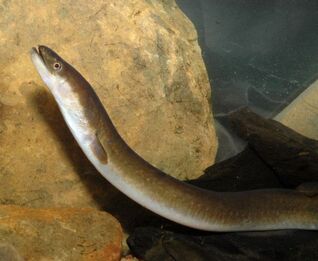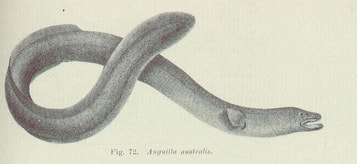 The short-finned eel swims more than 3000kms against the current to reach the Coral Sea. Photo: Arthur Rylah Institute
The short-finned eel swims more than 3000kms against the current to reach the Coral Sea. Photo: Arthur Rylah Institute By Gil Smith
IN AUGUST 2015 my partner Janice and I were walking on the beach at the end of Deep Creek Street, in Grantville, when we came across an eel measuring over 60 centimetres. It had travelled down Deep Creek on its way to the sea but was having trouble getting over the mudflats.
A local had just pulled up in the car park and we knew we had to rescue the eel before it was used for bait. We scooped it up in a discarded plastic bag, waded through the mud and released it in deeper water.
Intrigued by this sighting we went home and researched the eel. It turned out to be a short-finned eel. According to the Victorian Fisheries Authority, these eels can grow up to 1.1 metres long and 6.8 kilograms, and they form the basis of a valuable eel fishery.
IN AUGUST 2015 my partner Janice and I were walking on the beach at the end of Deep Creek Street, in Grantville, when we came across an eel measuring over 60 centimetres. It had travelled down Deep Creek on its way to the sea but was having trouble getting over the mudflats.
A local had just pulled up in the car park and we knew we had to rescue the eel before it was used for bait. We scooped it up in a discarded plastic bag, waded through the mud and released it in deeper water.
Intrigued by this sighting we went home and researched the eel. It turned out to be a short-finned eel. According to the Victorian Fisheries Authority, these eels can grow up to 1.1 metres long and 6.8 kilograms, and they form the basis of a valuable eel fishery.
They live in fresh water away from the coast in Eastern Australia, in this case the hills above Grantville. Our eel had made its way down Deep Creek into Western Port to embark on the next stage of its extraordinary life cycle.
Short-finned eels travel up 3-4000kms against the current to the Coral Sea, near New Caledonia. By the time they arrive, they have used up all their energy and are little more than a skeleton with gonads. They spawn and die.
When the young hatch and become elvers, they continue the life cycle by making the return journey to Australia and the fresh water their parents came from, including Deep Creek.
Short-finned eels travel up 3-4000kms against the current to the Coral Sea, near New Caledonia. By the time they arrive, they have used up all their energy and are little more than a skeleton with gonads. They spawn and die.
When the young hatch and become elvers, they continue the life cycle by making the return journey to Australia and the fresh water their parents came from, including Deep Creek.
 Illustration: Edgar R. Waite, Illustrated Catalogue of the Fishes of South Australia, G. Hassell & Son, Adelaide, 1921. Fig.72
Illustration: Edgar R. Waite, Illustrated Catalogue of the Fishes of South Australia, G. Hassell & Son, Adelaide, 1921. Fig.72 In 2016 we returned to Grantville after a lengthy holiday and were lucky enough to see another short-finned eel beginning its epic journey.
We didn’t see any last year. Apart from the lockdown, it was a very wet August so the eels would have found an easy passage to the sea.
Deep Creek and its environs are home to a surprising number of species. Boobook owls can be heard at night calling from the Dandy Premix quarry site, on the other side of the highway.
That stretch of highway is a scene of massive animal carnage, mainly wombats and kangaroos. A powerful owl, the largest owl in Australia, was found dead on the highway at the front of the quarry. Now there are plans to clear more bush to extend the quarry. What happens to the animals that inhabit that bush? Will they end up dead on the highway?
And if they quarry below the water table, as they intend to, what happens to Deep Creek? I read Dandy Premix’s environmental report, and there’s nothing about the impact on the animals that will be displaced.
Since residents cleaned up an area around Deep Creek it’s become a wonderful wildlife refuge. A 2020 birthday gift of a wildlife camera has enabled me to record wombats, wallabies, echidnas, ringtail and brushtail possums and native rodents that I have yet to identify.
My camera has also recorded some of the many birds that inhabit the Deep Creek area: superb fairy wrens, brown thornbills, eastern yellow robins, crimson rosellas and common bronze wing pigeons.
With my SLR camera I have photographed black-faced cuckoo shrikes, brown-headed and yellow-faced honeyeaters, eastern whipbirds, eastern spinebills, red and little wattlebirds, king parrots, kookaburras, magpies, Australian magpie larks, sulphur-crested cockatoo, yellow-tailed black cockatoos, galahs and little corellas.
At the mouth of Deep Creek I have photographed a banded lapwing, of which there have been very few sightings for the Bass Coast area, plus great egrets, white-faced herons, pacific and silver gulls, fairy martins, welcome swallows, the endangered hooded plover, white-breasted sea eagle, black-shouldered kites and white-throated needletails.
We didn’t see any last year. Apart from the lockdown, it was a very wet August so the eels would have found an easy passage to the sea.
Deep Creek and its environs are home to a surprising number of species. Boobook owls can be heard at night calling from the Dandy Premix quarry site, on the other side of the highway.
That stretch of highway is a scene of massive animal carnage, mainly wombats and kangaroos. A powerful owl, the largest owl in Australia, was found dead on the highway at the front of the quarry. Now there are plans to clear more bush to extend the quarry. What happens to the animals that inhabit that bush? Will they end up dead on the highway?
And if they quarry below the water table, as they intend to, what happens to Deep Creek? I read Dandy Premix’s environmental report, and there’s nothing about the impact on the animals that will be displaced.
Since residents cleaned up an area around Deep Creek it’s become a wonderful wildlife refuge. A 2020 birthday gift of a wildlife camera has enabled me to record wombats, wallabies, echidnas, ringtail and brushtail possums and native rodents that I have yet to identify.
My camera has also recorded some of the many birds that inhabit the Deep Creek area: superb fairy wrens, brown thornbills, eastern yellow robins, crimson rosellas and common bronze wing pigeons.
With my SLR camera I have photographed black-faced cuckoo shrikes, brown-headed and yellow-faced honeyeaters, eastern whipbirds, eastern spinebills, red and little wattlebirds, king parrots, kookaburras, magpies, Australian magpie larks, sulphur-crested cockatoo, yellow-tailed black cockatoos, galahs and little corellas.
At the mouth of Deep Creek I have photographed a banded lapwing, of which there have been very few sightings for the Bass Coast area, plus great egrets, white-faced herons, pacific and silver gulls, fairy martins, welcome swallows, the endangered hooded plover, white-breasted sea eagle, black-shouldered kites and white-throated needletails.